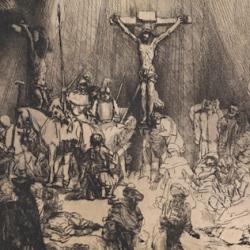Ian Hazlett (Martin Bucer, 78) observes that some Anabaptist groups taught “a radicalized Anselmian doctrine of the all-sufficiency of Calvary, by which Christ’s sacrificial death on the cross effects per se salvation for those who so believe. This reductionist externalization of Christ is then reinforced when it is also stressed that his body is now in heaven. Thereby Christ’s continuing real presence among believers on earth is endangered, or in some way diminished.”
They so emphasized the sufficiency of Christ’s death that they removed any need for church, sacraments, or ongoing mediation of any kind. Time might as well have stopped at the cross. That it didn’t was something of a problem for this view.
Hazlett admits that this is not pure Zwinglianism, but “one of the chief convictions among Lutherans about Zwinglian and putatively related ‘sacramentarian’ eucharistic doctrines was that the Christian faith was being emptied of its vital content, that the living Christ was excluded from the world, and that the faith was relegated to ‘fides historica’ (an historical belief). It was ultimately this anxiety which accounts for the intense vigour of Luther’s objection to what he believed he detected as sub-Christian in the Zwinglian theology.”
And it’s not just a Reformation-era problem. To this day, some Evangelical formulations of the sufficiency of the cross are hard to reconcile with the reality of sacraments and the church. Atonement theology supports the anti-sacramentalism of Evangelical Protestantism.
This led Bucer to emphasize the insufficiency of the cross: “For us it is not sufficient that he died for us on the cross. He himself must also live in us, and share with us the communion of his flesh and blood. For our [natural] flesh and blood are not able to inherit the kingdom of God. . . . he does not merely mediate for us with the Father, he also lives in us, suppresses our wicked flesh, and establishes a new, divine living; indeed he himself lives in us, after he has been presented, offered, and conveyed to us. Because normally (schlecht), it is by means of the church’s ministry that he communicates to us himself and his gifts” (79). Calvin argues for much the same position with his notion of the duplex gratia.
Opposition to Anabaptists led both Bucer and Calvin to an atonement theology that had considerable affinity with Aquinas. John a Lasco at least thought he spotted “Romanizing” tendencies in Bucer’s theology: “a Lasco was much less tolerant of Bucer. He challenges Bucer’s concept of koinonia. For a Lasco, eucharistic koinonia or communion is understood passively as the fellowship between Christ and believers, whereas Bucer, even if he does take passive communion for granted, pleads for an active communion as well – which requires a positive distribution, with the aid of the minister, of the body of Christ and its benefits. In Bucer’s highlighting of the normally necessary role of the minister, a Lasco sees a danger of ‘Romanization’, accompanied by adoration of the elements, processions and other abuses” (80).















